How to Find and Graph x and y Axis Intercepts Video Lesson
How to Find x and y axis intercepts
To find an x intercept, substitute y = 0 into the equation and solve for x.
To find the y axis intercept, substitute x = 0 into the equation and solve for y.
For example, find the 𝑥 and y intercepts of 2y + 3𝑥 = 12.
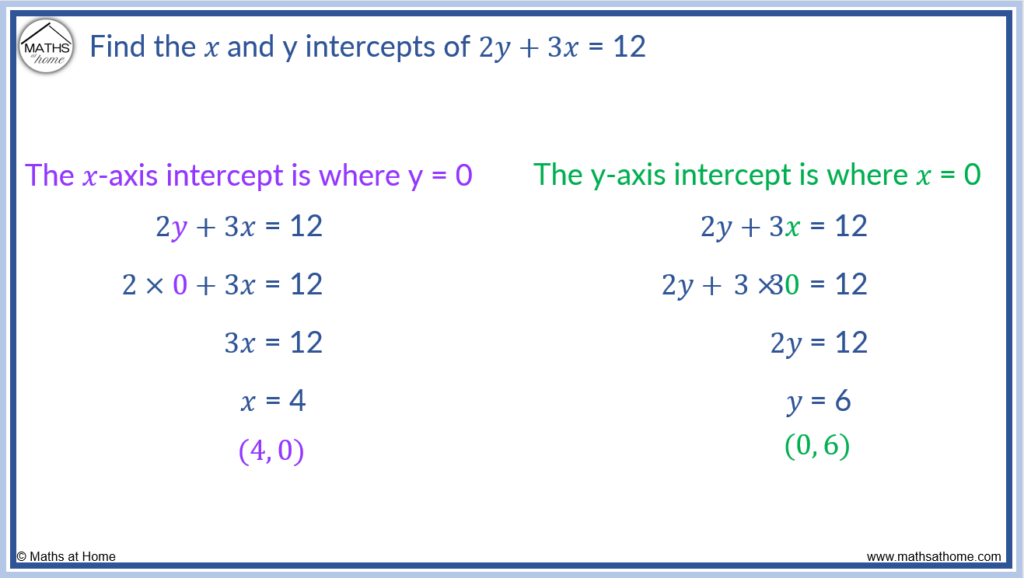
To find the 𝑥-axis intercept, first substitute y = 0 into the equation.
When y = 0, the equation 2y + 3𝑥 = 12 becomes 3𝑥 = 12.
Solve the resulting equation for 𝑥.
3𝑥 = 12 can be solved for 𝑥 by dividing both sides of the equation by 3.
𝑥 = 4 and so, the 𝑥-axis intercept has coordinates (4, 0).
To find the y-axis intercept, first substitute 𝑥 = 0 into the equation.
When 𝑥 = 0, the equation 2y + 3𝑥 = 12 becomes 2y = 12.
Solve the resulting equation for y.
2y = 12 can be solved for y by dividing both sides of the equation by 2.
y = 6 and so, the y-axis intercept has coordinates (0, 6)
What are 𝑥 and y Intercepts
The 𝑥 intercept is the coordinate where a graph touches or crosses through the 𝑥-axis. It has a y coordinate of 0. The y intercept is the coordinate where a graph touches or crosses the y-axis. It has an 𝑥 coordinate of 0.
The y-axis is the vertical axis that passes through the centre of the cartesian axes from bottom to top. It is marked with numbers known as y coordinates.
The 𝑥-axis is the horizontal axis that passes through the centre of the cartesian axes from left to right. It is marked with numbers known as 𝑥 coordinates.
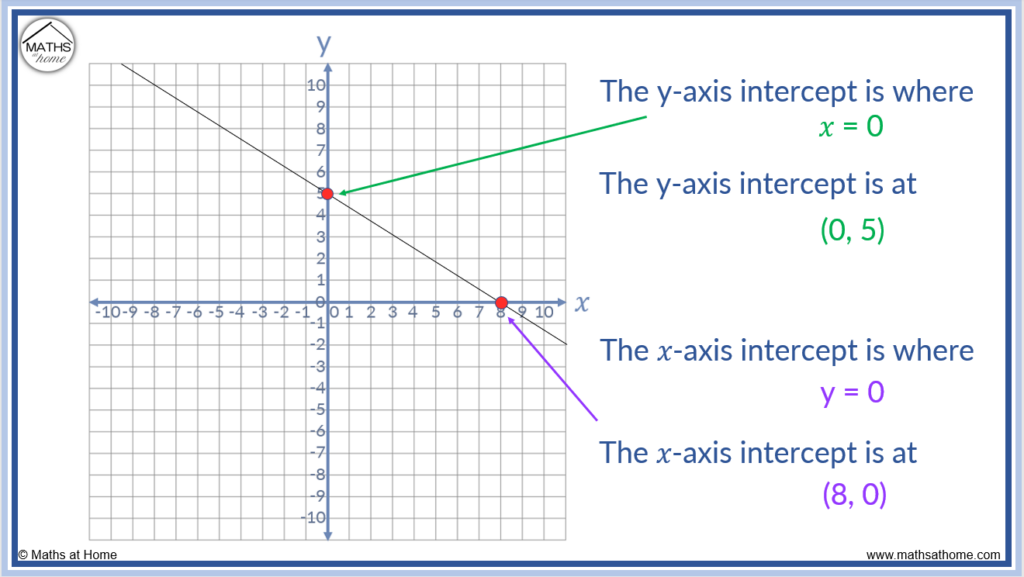
The y-axis intercept always has an 𝑥 coordinate of 0. In the example shown above, the y intercept is (0, 5) because it passes through the y-axis at y = 5.
The 𝑥-axis intercept always has a y coordinate of 0. In the example shown above, the 𝑥 intercept is (8, 0) because it passes through the 𝑥-axis at 𝑥 = 8.
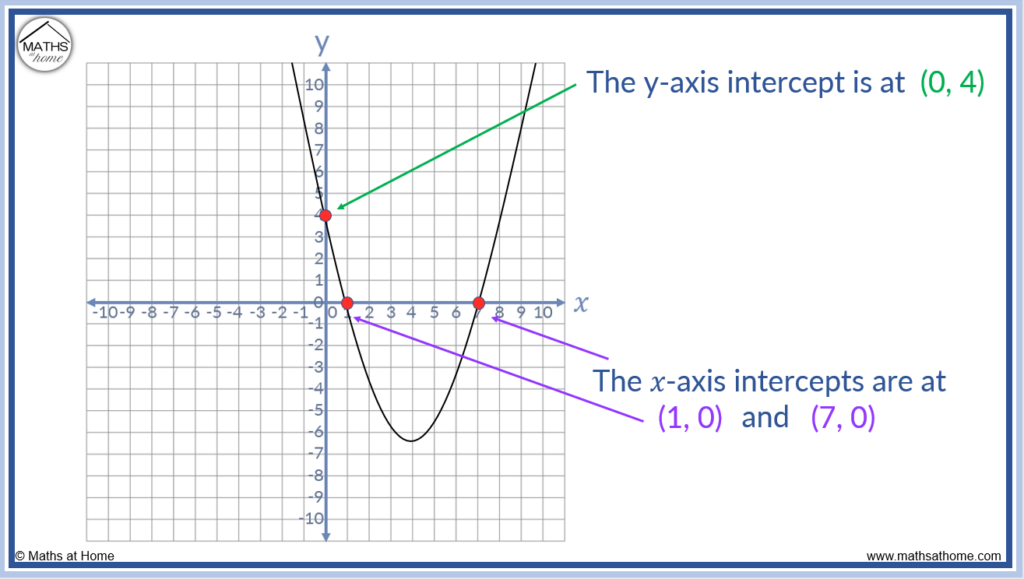
A function can only have one y-axis intercept. This is because a function can only have at most one output for any given input. When 𝑥 = 0, a function can only have one output which is the y intercept value. The number of 𝑥-axis intercepts depends on the type of equation.
For example, in the quadratic equation shown above, there is only one y intercept at (0, 4), however, there are two 𝑥 intercepts found at (1, 0) and (7, 0). There are two 𝑥-axis intercepts in a quadratic equation.
A relation can have an infinite number of 𝑥 or y intercepts depending on the equation of the relation. For example, a circle equation can have 0, 1 or up to 2 𝑥-axis and y-axis intercepts.

On the circle shown above, the y intercepts are marked at (0, -3) and (0, 5).
The 𝑥 intercepts are marked at (-8, 0) and (2,0).
y intercepts always take the form (k, 0). They always have an 𝑥 coordinate of 0.
𝑥 intercepts always take the form (0, k). They always have a y coordinate of 0.
How to Graph A Line using x and y Intercepts
To graph a line using x and y intercepts:
- Substitute 𝑥=0 into the equation to find the y-intercept.
- Substitute y=0 into the equation to find the 𝑥-intercept.
- Connect these two intercepts with a straight line.
For example, graph the linear function of y – 4𝑥 = 8.
Step 1. Substitute 𝑥 = 0 into the equation to find the y-intercept
When 𝑥 = 0, the equation y – 4𝑥 = 8 becomes y = 8.
The y-intercept is therefore (0, 8)
Step 2. Substitute y = 0 into the equation to find the 𝑥-intercept
When y = 0, the equation y – 4𝑥 = 8 becomes -4𝑥 = 8.
Dividing both sides by -4, we get 𝑥 = -2.
The 𝑥-intercept is therefore (-2, 0)
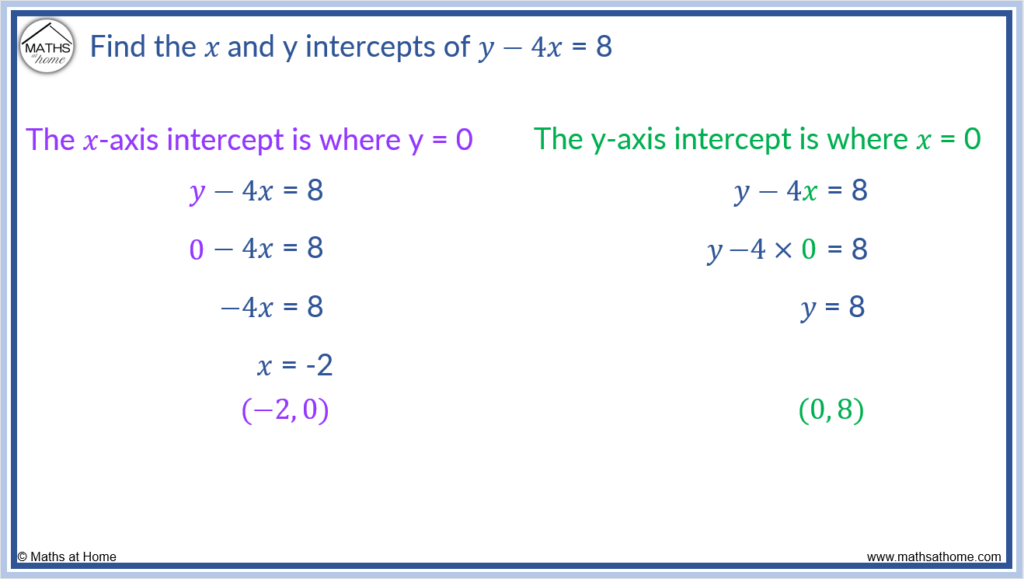
Step 3. Connect these two intercepts with a straight line
The two intercepts are plotted at (-2, 0) and (0, 8).
A straight line is then drawn between these two points to complete the graph.
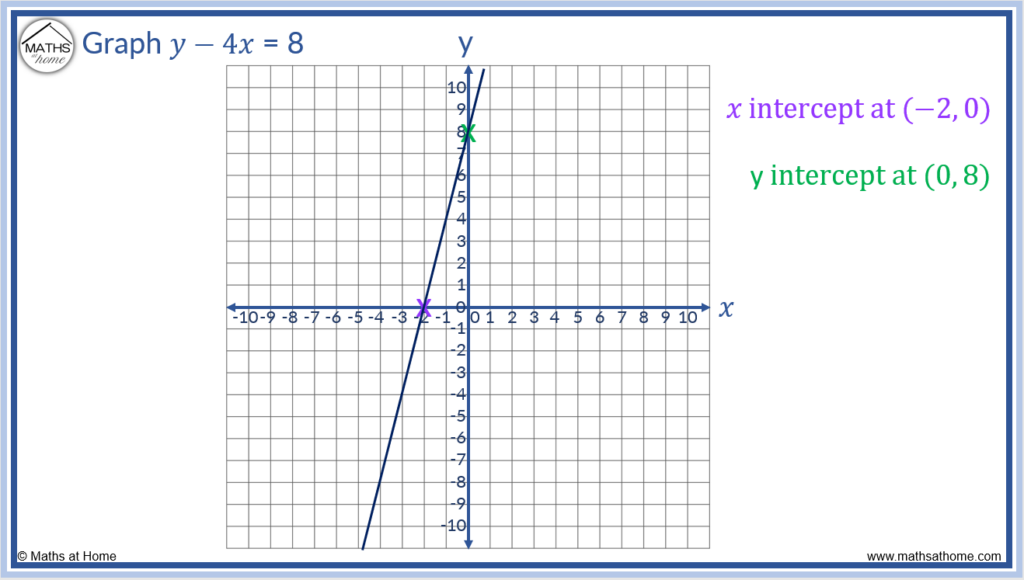
For example, the equation 3y + 3𝑥 =6 is written in standard form. Find the 𝑥 and y intercepts.
Here A = 3, B = 3 and C = 6.
Setting 𝑥 = 0, the equation 3y + 3𝑥 = 6 becomes 3y = 6 and so the y-intercept is y = 2.
The coordinate of the y intercept is (0, 2).
We can see that C/B becomes 6/3 which equals 2.
Setting y = 0, the equation 3y + 3𝑥 = 6 becomes 3𝑥 = 6 and so, the 𝑥-intercept is 𝑥 = 2.
The coordinate of the 𝑥 intercept is (2, 0)
We can see that C/A becomes 6/3 which equals 2.
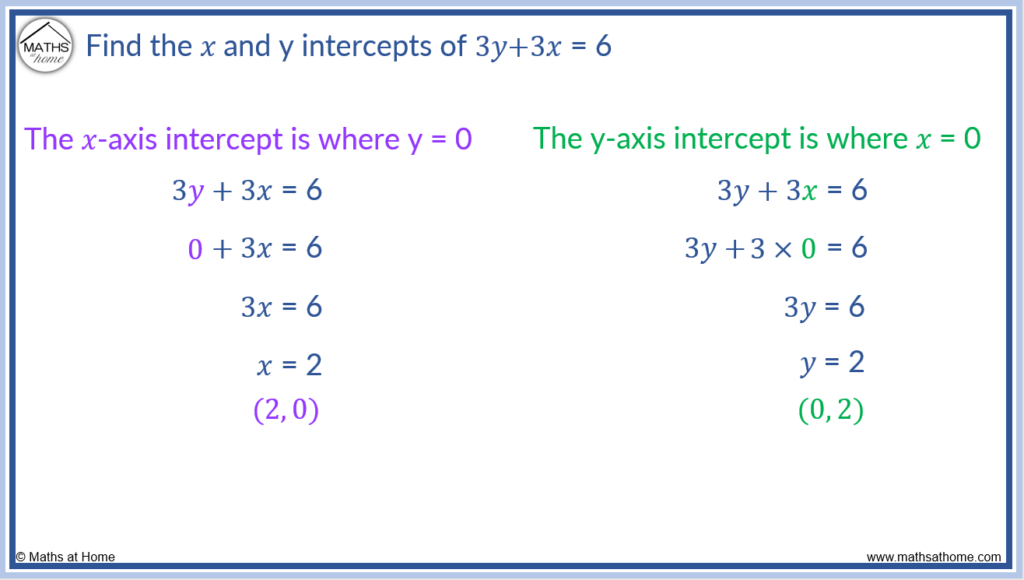
This standard form equation can now be graphed by plotting these two intercept coordinates and drawing a line between them.
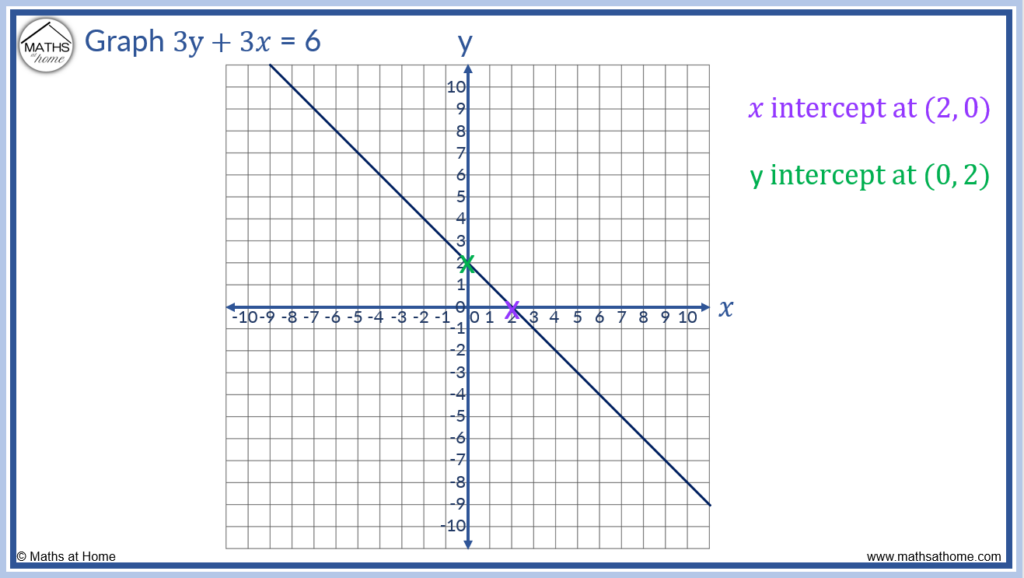
If the 𝑥 and y axis intercepts are the same, the line has a gradient of -1. For every one unit right, the line travels one unit down.
Finding the 𝑥 and y Intercepts with Fractions
To find the 𝑥 intercept, substitute y=0 into the equation and solve for 𝑥. To find the y intercept, substitute 𝑥 = 0 into the equation and solve for y. If there is a fraction following the substitution, multiply each term by the denominator and divide each term by the numerator to solve it.
For example, find the 𝑥 and y intercepts of .
To find the 𝑥 intercept, substitute y = 0 and solve for 𝑥.
This results in . Since there is a fraction, multiply by the denominator and then divide by the numerator.
Multiplying both sides of the equation by 3, the equation becomes 2𝑥 = 12.
Then dividing both sides of the equation by 2, 𝑥 = 6.
Therefore the 𝑥 intercept is found at (6, 0).
To find the y intercept, substitute 𝑥 = 0 and solve for y.
This results in . To find the intercept of this fractional equation, multiply both sides of the equation by the denominator of 2.
This results in 2y = 8.
Therefore the y intercept of this equation is (0, 8).
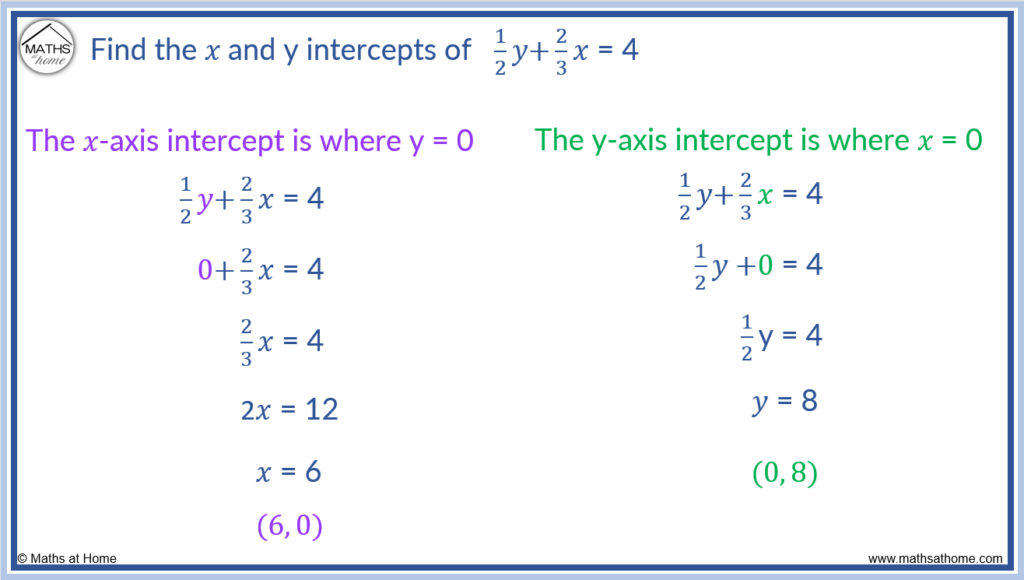
The line can be graphed by plotting the intercepts and drawing a line between them,

How to Find 𝑥 and y Intercepts for a Linear Function
A linear equation is written in the form y = mx + b. b is the constant term and is the value of the y-intercept. The x-intercept is the value of x when y = 0. For a linear function, the x-intercept is equal to -b/m. For example, y = 2x – 6 has a y-intercept of -6 and an x-intercept of 3.
In linear equations of the form, y = m𝑥 + b, the value of m is the coefficient of 𝑥 and b is the constant term. This means that m is the value 𝑥 is multiplied by and b is the number on its own.
When written in slope-intercept form, the equation of a straight line is y = m𝑥 + b.
To find the 𝑥 intercept, set y = 0 and solve for x.
y = m𝑥 + b becomes 0 = m𝑥 + b.
We can rearrange this for 𝑥 to get 𝑥 = -b/m.
To find the y intercept, substitute 𝑥 = 0 and solve for y.
y = m𝑥 + b becomes y = b.
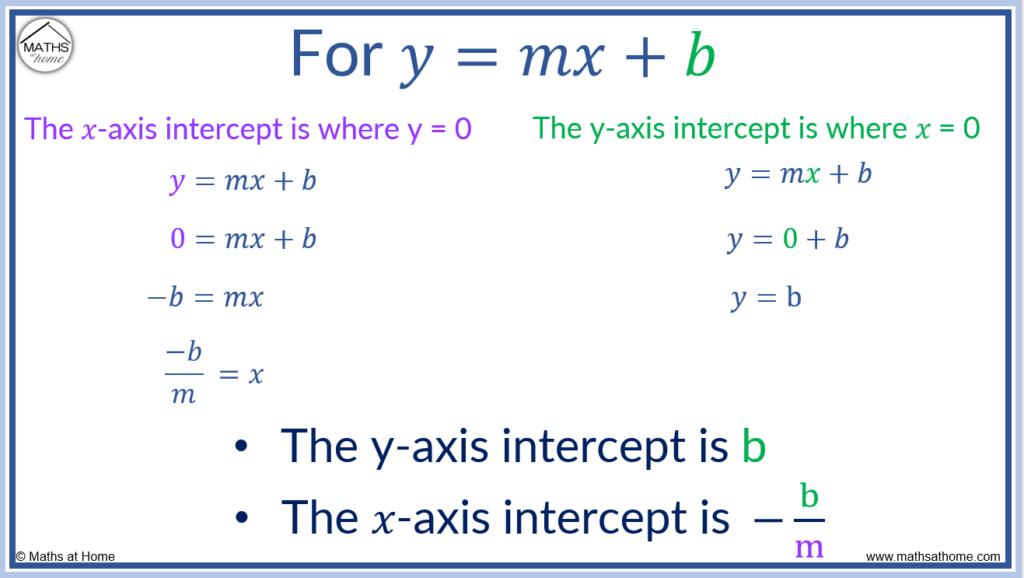
For example, in the equation y = 2𝑥 – 6, m = 2 and b = -6.
Therefore the y-axis intercept is b, which is -6. The y intercept is at (0, -6).
The 𝑥-axis intercept is -b/m, which is 6/2 which is 3. The 𝑥 intercept is at (3, 0).

The same results for the 𝑥 and y intercepts can be found by substituting y = 0 and 𝑥 = 0 respectively into the equation y = 2𝑥 – 6.
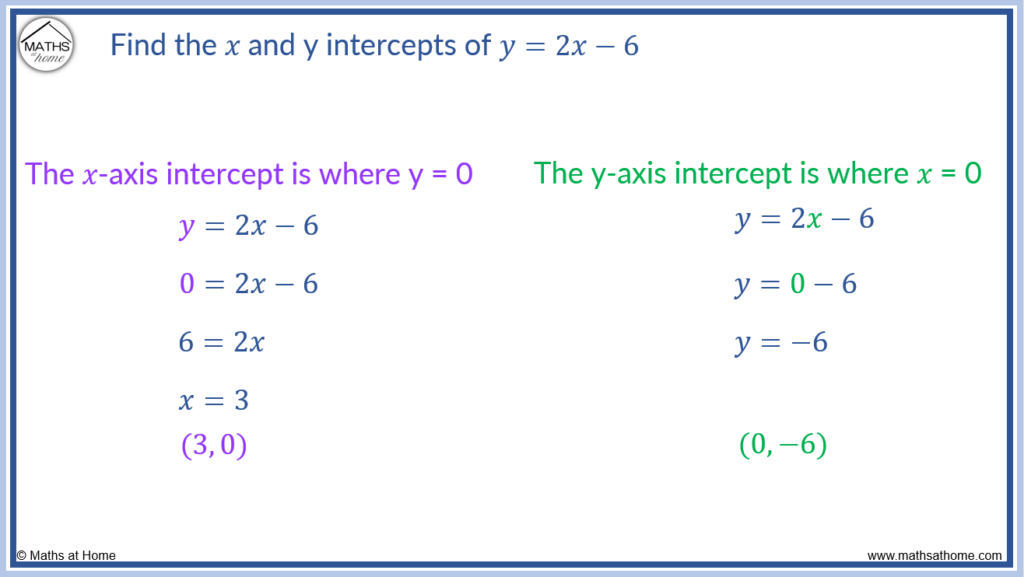
Finding 𝑥 and y Intercepts for Rational Functions
To find the x-axis intercept of a rational function, substitute y = 0 and solve for x. The x-axis intercept is therefore found when the numerator of the rational function equals zero. The y-axis intercept is found by substituting x = 0 into the function and evaluating the result.
For example, find the 𝑥 and y intercepts for .
To find the 𝑥-axis intercept, set y = 0.
becomes
.
We can multiply both sides of the equation by 𝑥 + 1 to get . We can skip to this part of the solution when we are finding the 𝑥 intercept of a rational function.
Simply set the numerator equal to zero.
Therefore 0 = (𝑥+2)(𝑥-2).
Setting each bracket equal to zero, the solutions become 𝑥 = -2 and 𝑥 = 2.
The 𝑥-intercepts are (-2, 0) and (2, 0).
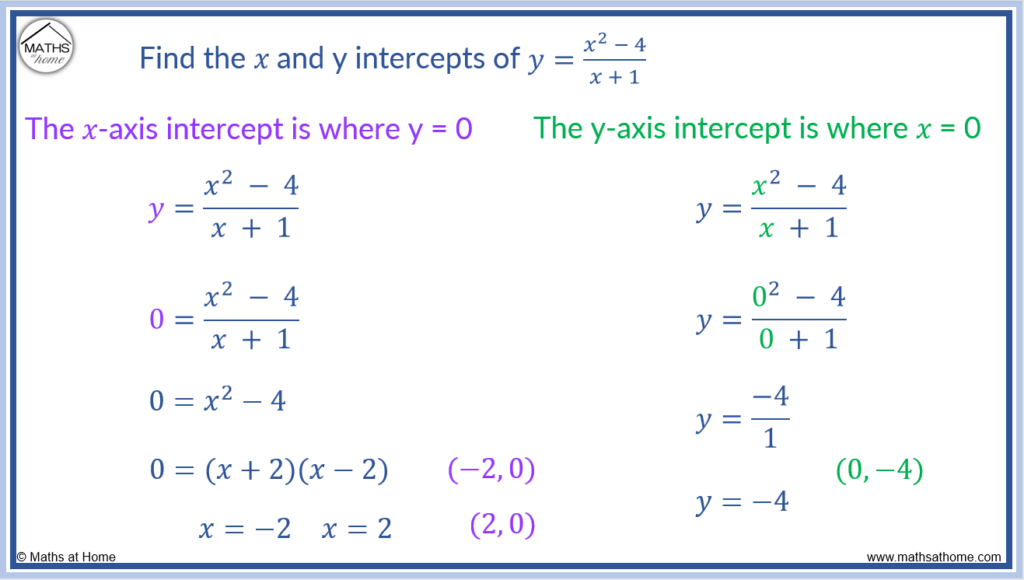
To find the y-axis intercept, substitute 𝑥 = 0 into the function.
becomes
which becomes
.
y = -4 and so, the y-axis intercept is (0, -4).
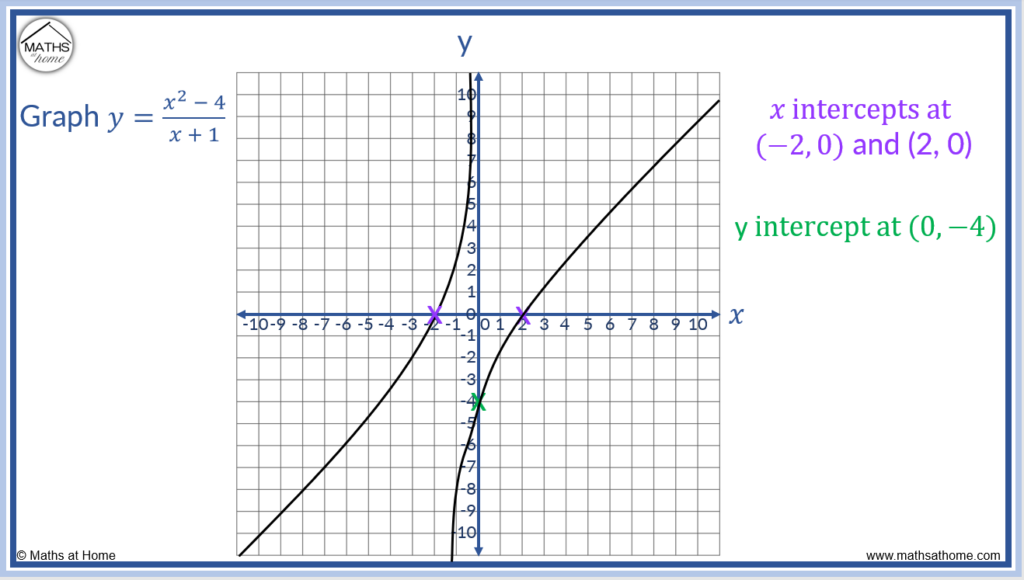
Finding 𝑥 and y Intercepts for a Parabola
A parabola of the form y = ax2 + bx + c has only one y-axis intercept at (0, c). The parabola can have up to two x-axis intercepts which are its roots or zeros. To find the x-axis intercepts, set y = 0 and solve the quadratic equation using the quadratic formula or by factorisation.
For example, find the 𝑥 and y intercepts of y = 𝑥2 – 8x + 7.
The y-intercept can be found by substituting 𝑥 = 0 into the equation. This results in y = 7.
More simply, the y-intercept is at (0, c). In the equation y = 𝑥2 – 8x + 7, the value of c is 7. Therefore the y-axis intercept is at (0, 7).
To find the 𝑥-axis intercepts, we set y = 0 and solve for 𝑥.
y = 𝑥2 – 8x + 7 becomes 0 = 𝑥2 – 8x + 7. We can factorise the equation to get (𝑥 – 1)(𝑥 – 7) = 0.
Therefore, setting each bracket to equal 0, the solutions are 𝑥 = 1 and 𝑥 = 7. Therefore the 𝑥-axis intercepts are at (1, 0) and (7,0).
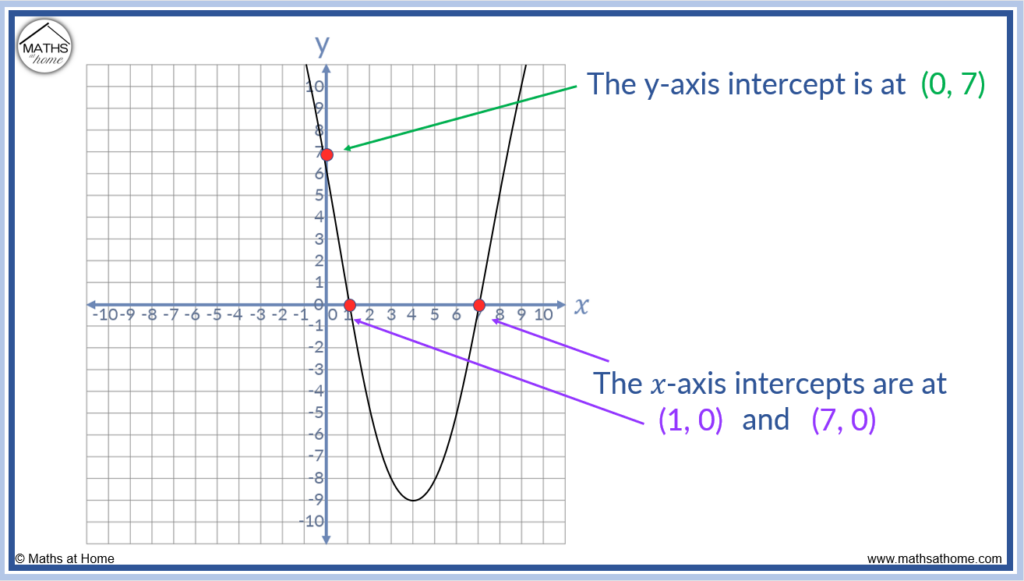
The quadratic formula can be used to find the 𝑥-axis intercepts of any parabola.
The quadratic formula tells us that . This means that the first 𝑥-axis intercept is found at
and the second 𝑥-axis intercept is found at
.
For the equation y = 𝑥2 – 8x + 7: a = 1, b = -8 and c = 7.
The quadratic formula, becomes
, which simplifies to
, which results in 𝑥 = 1 and 𝑥 = 7.
For any quadratic function, the axis of symmetry is found exactly in between the 𝑥-axis intercepts. To find the axis of symmetry using the 𝑥-intercepts, simply add the 𝑥 coordinates of each 𝑥-axis intercept and then divide this result by 2.
The two 𝑥 intercepts are at 𝑥 = 1 and 𝑥 = 7. Adding 1 and 7 and then dividing by 2 gives us 𝑥 = 4.
The equation of the axis of symmetry is 𝑥 = 4.
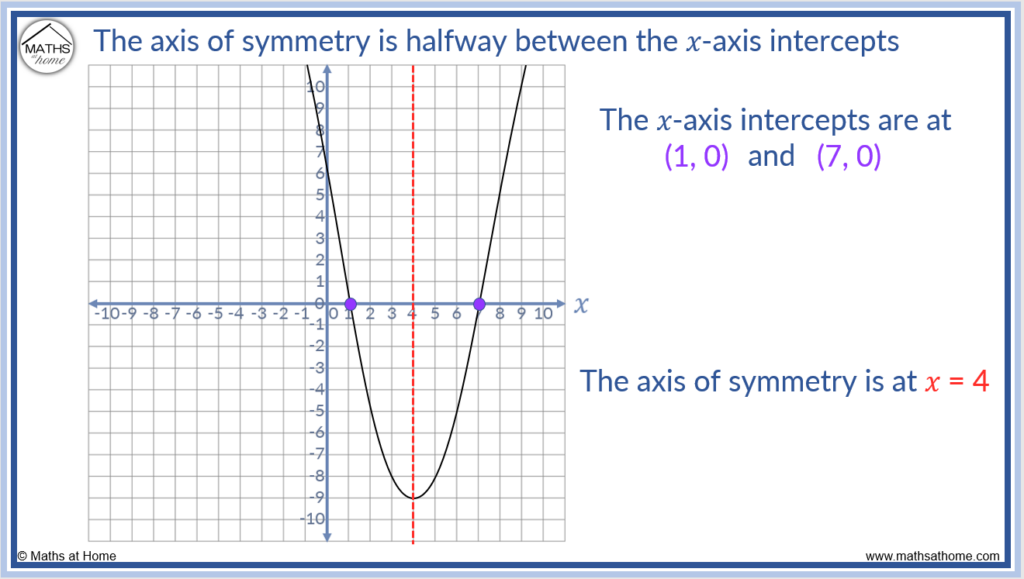
The vertex is the turning point of a quadratic graph. The vertex of any quadratic, a𝑥2 + b𝑥 + c lies on its axis of symmetry.
Therefore the 𝑥 coordinate of the vertex is always exactly halfway between the two 𝑥-axis intercepts of the quadratic at . The y coordinate of the vertex can then be found by substituting this value of 𝑥 into the original quadratic function.
For the equation, y = 𝑥2 – 8x + 7, the equation for the 𝑥 coordinate of the vertex becomes
. This equals 𝑥 = 4.
This means that the 𝑥 coordinate of the vertex is 4.
To find the y coordinate of the vertex, simply substitute the 𝑥 coordinate of the vertex into the original quadratic equation.
𝑥2 – 8x + 7 is equal to -9 when 𝑥 = 4.
Therefore the coordinates of the vertex are (4, -9).
Finding 𝑥 and y Intercepts for a Circle
To find the x-intercepts of a circle, substitute y = 0 and solve the resulting quadratic for x. To find the y-intercepts of a circle, substitute x = 0 and solve the resulting quadratic for y. A circle may have 0, 1 or 2 x-axis or y-axis intercepts depending on the number of solutions to the quadratic.
For example, find the 𝑥 and y intercepts of (𝑥+3)2 + (y-1)2 = 25.
To find the 𝑥 intercept, substitute y = 0 to get (𝑥+3)2 + (0-1)2 = 25.
This becomes (𝑥+3)(𝑥+3) + (-1)2 = 25.
Expanding this, we get 𝑥2 + 6𝑥 + 9 + 1 = 25. We set a quadratic equation equal to zero to solve it.
We get 𝑥2 + 6𝑥 – 15 = 0. This cannot be factorised but solving this with the quadratic formula we get 𝑥 = -7.90 or 𝑥 = 1.90.
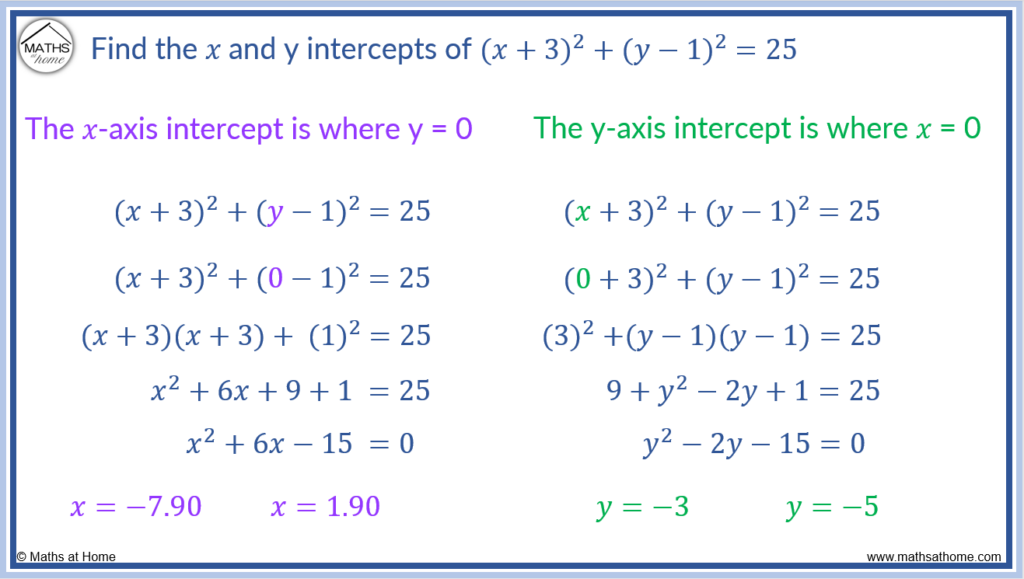
To find the y intercepts of a circle, set 𝑥 = 0 and solve the resulting quadratic equation for y.
(𝑥+3)2 + (y-1)2 = 25 becomes (0+3)2 + (y-1)2 = 25.
This becomes (3)2 + (y-1)(y-1) = 25 which can be expanded to get 9 + y2 – 2y + 1 = 25.
Setting this quadratic equation equal to zero, we get y2 – 2y – 15 = 0.
This can be factorised to get (y-5)(y+3) = 0, which gives us the solutions of y =5 or y = -3.
These 𝑥 and y intercepts are shown on the graph of the circle below.

𝑥 and y Intercepts From a Table
A table of x and y values make up pairs of coordinates. The x-intercept is found from the row in the table with a y coordinate of 0. The y-intercept is found from the row in the table with an x coordinate of 0.
The table below shows the table of coordinates formed from the function y = 2𝑥 – 4.
The y-axis intercept is seen to be (0, -4). This is the only pair of coordinates that have an 𝑥 value of 0.
The 𝑥-axis intercept is seen to be (2, 0). This is the only pair of coordinates that have a y value of 0.
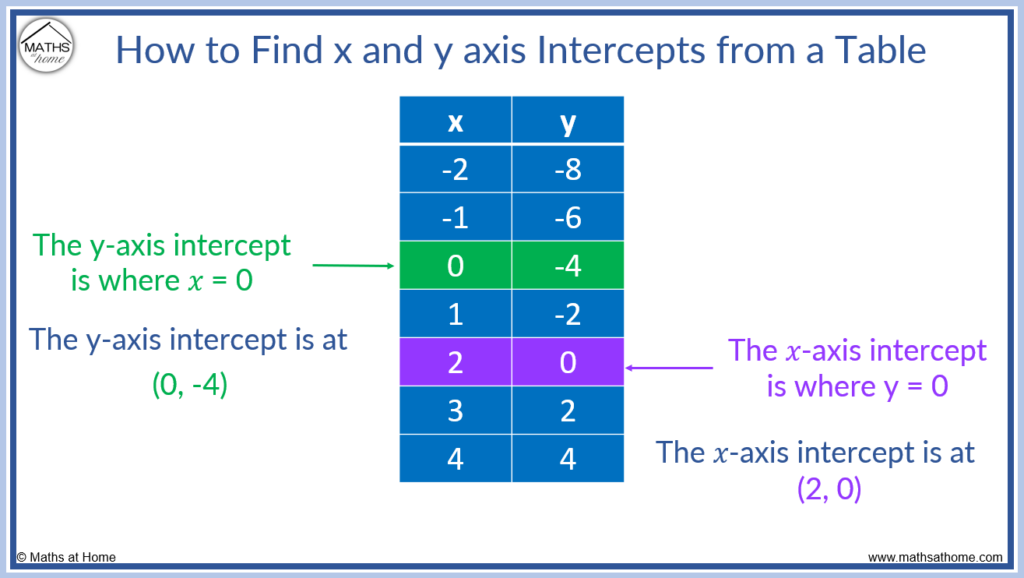
How to Find the x and y Intercepts from 2 Points
To find the x and y intercepts from 2 points, first find the equation of the line. The x intercept can be found by substituting y = 0 into the equation of the line. The y intercept can be found by substituting x = 0 into the equation of the line.
Finding the y Intercept From 2 Points
To find the y intercept from 2 points:
- Find the gradient of the line by dividing the difference in the y coordinates by the difference in x coordinates.
- Substitute this gradient, m into the equation y=mx+c along with the x and y values of one of the coordinates.
- Use these values to work out c, which is the value of the y-intercept.
For example, find the y intercept of the line passing through (2, 3) and (4, 9).
Step 1. Find the gradient by dividing the change in y coordinates by the change in x coordinates.
Between the y coordinates of 3 and 9 there is a change of +6.
Between the x coordinates of 2 and 4 there is a change of +2.
6 ÷ 2 = 3 and so the gradient = 3.
Step 2. Substitute the gradient, m into the equation y = mx + c along with the x and y values of one of the coordinates.
We call the gradient m. Therefore as calculated in step 1, m = 3.
We now select the x and y values from either coordinate. We will choose (2, 3) so x = 2 and y = 3.
Substituting m = 3, x = 2 and y = 3 into y = mx + c,
we get 3 = 6 + c.
Step 3. Use these values to work out c, the y-intercept.
Since 3 = 6 + c, the value of c = -3.
Therefore the y intercept is y = -3.
The y-intercept is (0, -3).
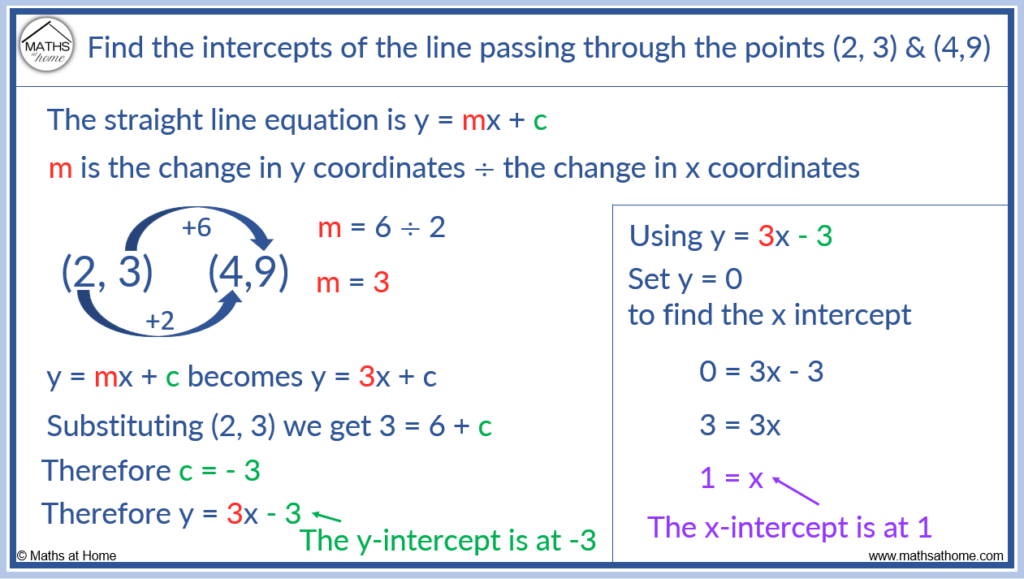
Finding the x Intercept from 2 Points
To find the x intercept from 2 points:
- Find the equation of the line using the two points.
- Substitute y=0 into the equation of the line.
- Solve the resulting equation for x.
Step 1. Find the equation of the line using the 2 points.
As seen in the steps above, the equation of the line is y = 3x – 3.
Step 2. Substitute y=0 into the equation of the line.
y = 3x – 3 becomes 0 = 3x – 3.
Step 3. Solve the resulting equation for x.
0 = 3x – 3 can be solved by adding 3 to both sides.
3 = 3x
We divide both sides by 3 to get x = 1.
The x intercept is found at (1, 0).
